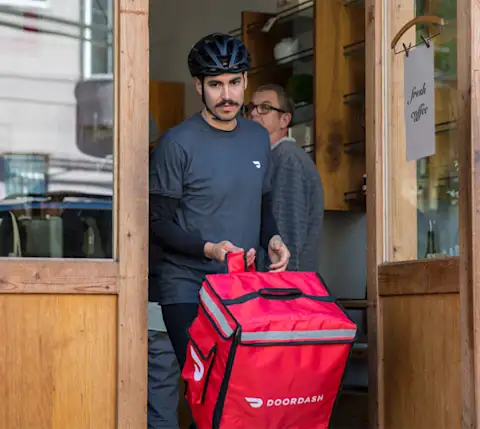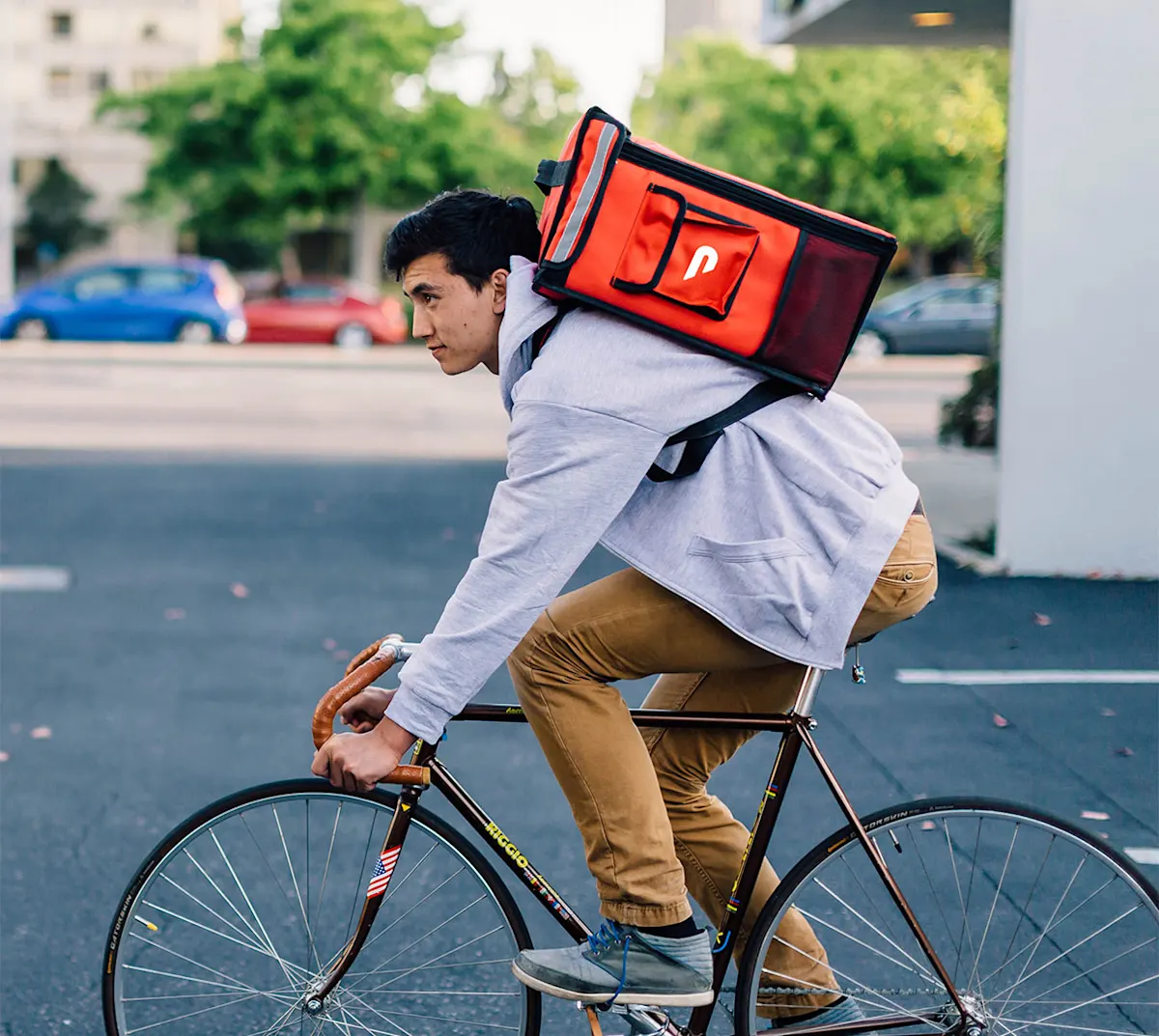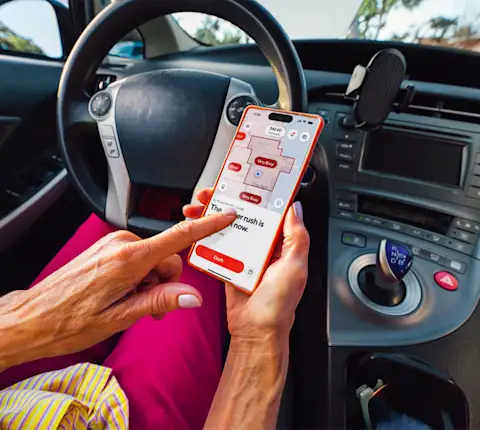Introduction
The following guidance was designed to help you stay safe while dashing. Each section will walk you through advice for that particular subject. If you have any questions about safety on DoorDash after reviewing this content, visit Dasher Support at help.doordash.com.
Vehicle safety
Riding safely helps you avoid accidents and minimise risk on the road. Here are some best practises to stay safe while dashing by bike:
Common causes of accidents
It’s important to understand the risks of the road and common causes of cycling accidents. A few important hazards to be aware of while riding include:
Time of day
Most crashes involving bicycle riders occur on weekdays in the late afternoon. At this time of day, the vision of all road users can be impaired due to the setting sun, there is often a heavier flow of traffic, and some drivers will be experiencing fatigue. Try to keep a buffer space between you and other road users.
Intersections
Drivers may not see bicycle riders coming through at intersections. When passing through an intersection, try to make eye contact with drivers who might cross your path to ensure that you are noticed. Also scan the road when approaching intersections and assess other vehicles that may be approaching from different directions.
Joining the road
If you wish to join the traffic from a kerb, it’s recommended that you find a point where you have a good line of sight to traffic movement on the road. Don’t leave the path between parked vehicles as oncoming drivers will not be able to see you.
Turning vehicles
Be alert to vehicles that may cross in front of you. This could be a vehicle turning left or right into a street or driveway. Pay particular attention to cars when you are travelling on the left hand side of a queue. Often vehicles will turn across your path if there is a gap in the queue.
Parked cars
When passing parked cars, always be on the lookout for opening car doors. Passengers might not look before swinging a door open in your path, so always look through car rear windows to determine whether or not an occupant is about to get out. Parked cars may also suddenly pull out from the kerb, so look for clues that a car might be about to move. These can be:
A flash of the brake or reversing lights
The right hand indicator suddenly comes on
Front wheels moving or changing direction
You should also slow down or keep a buffer zone between you and any parked cars. Use your bell or horn to signal your approach to vehicle occupants.

Protective equipment
Bicycle helmets
When riding, you are required by law to wear an approved bicycle helmet securely fitted and fastened on your head. Look for the sticker certifying the helmet meets Australian and New Zealand standards (AS/NZS2063) displayed on the helmet to ensure it has passed safety tests.
Your helmet must:
Be approved and conform to Australian and New Zealand standards
Be a good fit
Have a number of ventilation holes or openings
Be layered with thick, energy absorbing hard foam
Not obstruct your vision
Be lightweight for comfort
Have adjustable straps
Not have been damaged or involved in a crash.
To fit your helmet correctly and maximise its effectiveness in the event of a crash:
Position the helmet on your head and tilt it forward until the front of the helmet is two fingers above the bridge of your nose.
Fasten and straighten the helmet buckles and straps and adjust for a snug fit.
One finger should be able to fit between the buckle and your chin while the helmet is firmly in place on your head.
Avoid wearing anything under the helmet such as a hat or beanie as this may affect the correct fitting of the helmet on your head. It may also hinder ventilation causing you to become dehydrated.
Reflective gear
Bicycle riders are vulnerable road users and must take precautions to ensure they are highly visible when riding. To make it easier for other road users to see you, food delivery riders should:
Always wear fluorescent and/or reflective clothing
Have reflective strips affixed to all visible parts of your delivery bags, including the front, the whole width to the rear and sides of the bag, as well as on the straps facing the front
Consider wearing a fluorescent helmet or adding reflective strips to your helmet.
Any additional retro-reflective strips are best attached to the front, sides and rear of the helmet. Care should also be taken so that the strips are not applied where they cover vents, visors or straps.
Reflective strips are available in the Dasher store at doordashaustraliastore.com
Conditions
You should assess the road conditions to determine if it is safe to ride, prior to heading out dashing. Dress accordingly, and ensure you have the correct equipment. Here are tips for riding in different conditions.
If rain is a possibility, take a good weatherproof jacket and waterproof pants to help keep you dry.
Use your front and rear lights and wear a reflective vest to make yourself more visible to other traffic.
In wet weather, take corners slower as there will be reduced traction between your tyres and the road and stay upright rather than leaning into corners with your hips.
Apply the front and rear brake smoothly and prepare yourself well in advance before entering a corner to stop your tyres skidding.
Avoid hazards such as potholes and storm water grates. If you're riding along a poorly drained road, avoid water channels by moving towards the centre of your lane.
On sunny days, wear sunglasses to protect your eyes from glare and sunscreen to protect your skin..
If it’s warm, wear clothing that allows good airflow between fabric and skin. This will ensure you keep cool as you ride.
Lights
It is always a good idea to ride with bike lights, even if you are riding in the middle of the day. Flashing lights will get the attention of other motorists and let them know that you are there.
When using lights, you should attach a white light to the front of the bike facing forward, and a red light to the back of the bike facing backwards. It is also wise to have front and rear reflectors attached that are the same colour as your lights.
Speed
Speeding is the number one killer on roads. On average, it is a factor in around 40 percent of deaths and 20 percent of serious injuries each year.
You should ride to the road conditions. Even if riding at or below the speed limit, you may be going too fast for the conditions, such as curves, rain, heavy traffic or in darkness.
Load balance
Load balance while riding is an important safety factor to consider, and using the right equipment will help you stay safe and upright while on the road.
It is recommended that you use a backpack style hot-bag when completing deliveries or tasks on a bike so that the weight of the items is balanced while riding.
When loading your Bike-hot bag, take care not to put too much weight in it as this can put strain on your back or make the bag unbalanced while riding. The general rule is if you can’t carry the bag with one arm, it’s too heavy.
The DoorDash system is designed so that while on a bike, you are not sent offers for orders that are too large or heavy. If you do find that an order is too large, do not attempt to make the delivery, please reach out to support who will be able to reassign you from the order.
In the Dasher store, you can find reflective delivery bags designed in partnership with the Dasher community. These bags are designed to be retroreflective, allow you to safely carry food deliveries while riding, and consider ergonomics for riding. You can order a Dasher bag in the Dx store at doordashaustraliastore.com
Bicycles and maintenance
Purchasing a new bike
Bicycles sold in New Zealand must have markings or labels to certify compliance to AS/NZS 1927:1998 Pedal bicycles -Safety requirements. This marking or label should be clear and legible on the frame.
Maintenance
Riders should carry out a 3-step check every time they ride their bike:
Tyres should feel firm to touch
Check the seat is at the correct height
Check brakes and gears operate smoothly.
Riders should also perform regular maintenance checks and have their bicycles professionally serviced at regular intervals, at least once a year, to ensure it is in the safest condition.
E-bike safety
If you've decided to dash with an e-bike, here are some important safety measures to be mindful of when it comes to battery regulations, and storing and charging your e-bike, as outline by the NSW government.
Smoke Alarms: Ensure you have a working smoke alarm installed where you charge your e-bike or e-battery, and test your smoke alarm regularly.
Battery Charging Safety
Do not modify your e-bike, its battery, or its charger.
Ensure the battery is charged in a location that does not block a doorway or exit.
Always use the recommended charger that came with your device.
Charge your e-bike in a safe dry location, away from flammable materials and heat sources (e.g. heater).
Never leave your e-bike charging unattended.
New Safety Standards + Training Record: Be aware that new safety standards for lithium-ion batteries in e-mobility devices came into effect on 19 February 2025, and ensure you carry your training verification record while on deliveries.
For more details, please refer to the following official resources:
Lithium-ion batteries: shop, charge, and recycle safely | NSW Government
Fair Trading NSW - New safety standards for lithium-ion batteries in e-mobility devices
Lithium-ion battery safety campaign kit - Fire and Rescue NSW
Phone usage
Research shows that using a mobile phone while driving can increase the risk of having a casualty crash by four times. Although phones are necessary for completing orders, you should always be fully stopped when using a phone to check or complete orders. There are significant penalties for illegal mobile phone use.
While riding you should use your phone only for navigation while placed on a phone mount.
A rider may use a mobile phone for navigation and dispatch, however the phone must be secured to the motorcycle or bicycle in a mobile phone holder.
The only other mobile phone functions a rider can use are making or receiving an audio phone call, and playing audio (such as music).
When using navigation apps on your phone, match this to your type of vehicle. Routes generated for bikes will differ from car routes, so it is important you correctly select the right vehicle so you are not directed somewhere you shouldn’t be.
Phone mounts are available in the Dasher store at doordashaustraliastore.com
Parking and theft
Be mindful of the potential for theft when picking up and dropping off your order. Always check your local laws about commercial and general bike parking before dashing.
Whenever possible:
Always lock up your bike when it is unattended, even if only for a few moments.
Park your bike in highly visible areas and look for well lit areas if parking your bike at night.
If dedicated bike parking is not available, make sure your parked bike is safely secured and that your parked bike does not impede other users.
Always take accessories that can be easily stolen or ensure they are locked to your bike.

Tips and road rules
As a bicycle rider, it’s very important to know how to respond to the road environment. Take the time to understand the road rules and gain riding experience before you ride in traffic.
Always obey the road rules, including traffic lights, speed limits, stop signs and give way signs.
Allow pedestrians a metre of space on shared paths, where possible.
Always travel at a speed that is safe for you and the pedestrians around you, especially if you are riding on a bike path shared with pedestrians.
When approaching pedestrians, always ring your bell, slow down and prepare to stop and give way.
Ride in a predictable manner so that other road users do not have to react suddenly to your movements. Do not weave between vehicles.
Give hand signals when changing lanes or turning left or right.
Be in control of your bicycle. It is an offence to ride with both hands off the handlebars, feet off the pedals or to carry anything that prevents you from having control.
Check for hazards
Maximise your safety when riding by constantly assessing your environment for any hazards. Scan the road for holes, gaps, uneven surfaces, debris and regularly look over your shoulder to check what is beside and behind you. Do not wear headphones when riding. You must be able to hear potential hazards so you can react quickly.
Avoid blind spots
A blind spot is an area outside a motor vehicle that cannot be seen in the rear or side mirrors of the vehicle. When riding in traffic, it is important to increase your visibility by keeping away from motor vehicle blind spots.
Don't rush
The DoorDash system is designed so that it factors your type of vehicle, and live traffic condition into the estimated delivery time. This means you don't need to rush when making your way to a restaurant or customer. Ride to the conditions and road rules, and if there is an unforeseen issue while on route, get in touch with Dasher support.
Impaired riding
Alcohol and other substances
Drunk driving is one of the major causes of death on Australian roads. If you are drinking or have been recently, do not dash, even if you feel unaffected. Alcohol is a depressant, and it reduces your ability to drive safely because it:
Slows your brain functions, reducing your ability to react or make quick decisions in time.
Reduces your ability to judge speeds (yours and others), and your distance from other cars, people or objects.
Gives you false confidence and you may take greater risks because you think your riding is better than it is.
Makes it harder for you to do more than one thing at a time, i.e. while concentrating on steering, you could miss things like traffic lights, cars and pedestrians.
Makes you drowsy and increases your chances of falling asleep while riding.
Alcohol will also remain in your system for a long time after your last drink. It can take more than 18 hours for your blood alcohol concentration to get back to zero.
Both illegal and prescription drugs can increase your crash risk by impairing your driving ability. As a driver, you need to be able to react quickly to changing situations on the road, which requires clear judgement and concentration.
Different drugs can affect you in different ways. If you think you might have drugs in your system that could affect your ability to drive, do not dash.
Some medicines can affect your ability to drive safely as they can cause drowsiness, blurred vision, poor concentration, slower reaction times and changes in behaviour. Read the labels on medication to determine whether it could affect driving. If the warning label tells you not to drive, you should not dash.
Fatigue
Driving or riding while fatigued or impaired can have significant consequences as it affects your concentration and judgement. Research has shown that fatigue can be as dangerous as other road safety issues, such as drunk driving.
Before you even get in your car, ask yourself:
Am I okay to drive?
Have I had enough rest?
Can I make safe decisions?
Tips for managing fatigue:
Get at least eight hours of sleep.
Avoid riding when you would normally sleep.
Know when it's time to rest and take regular breaks.
Take a nap, 20 minutes works best.
Research shows that being awake for about 17 hours has a similar effect on your driving as a blood alcohol concentration (BAC) of 0.05. Driving tired is not only a problem on long drives or at night. It can also affect shorter, everyday trips. While dashing, you will receive a reminder every time you’ve been on a 4 hour consecutive shift. Please pause and take a rest to recover during this time.




